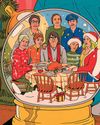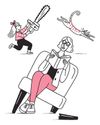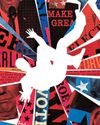
There is little else that the cat can do. All one can do is attempt to watch the animal as it performs its actions, with time suspended and meaningless. As it does, the painful history from the first to the last, the dirt back roads, the chains, and the rattle of iron, are voided in the cat—that dusty old symbol, the red open mouth at the end of a Poe story, a freakish shadow, razor teeth crying behind a wall.
•
What matters is that they were walking that day in opposite directions along the same path, with the neo-Gothic buildings of the university framing a sombre Chicago sky. There was William’s smile and then his voice as Kayla heard it for the first time. She was from a place called Sparks, not far from Reno, a neat little bungalow house on a street snaked with asphalt seam sealer. There was an exchange of words, an adjusting of bodies into casual positions and a forward movement, slightly dancelike, as they talked. It was his freckles, and the frankness of his eyes, and the commonality of the place where they met, too, the way their paths crossed into the initial physical contact—he was looking at his phone when he bumped into her, sent her staggering back—and the comic aspect of the way their bodies touched that afternoon.
•
What matters is that a few weeks later the two of them found him on the corner of Fifty-third and Woodlawn, a street cat with matted black fur and a smear of white cutting across his face at an odd angle that broke the symmetry of his features but made him oddly beautiful. His paws were bloodied and his eyes bloodshot and, when she went to him, he let himself be lifted into her arms and then he relaxed, sagging. It was a cool fall night. “I want to keep him,” she said, and he said, “Yeah, let’s keep him, yes,” and they took him to her apartment.
•
This story is from the January 22, 2024 edition of The New Yorker.
Start your 7-day Magzter GOLD free trial to access thousands of curated premium stories, and 9,000+ magazines and newspapers.
Already a subscriber ? Sign In
This story is from the January 22, 2024 edition of The New Yorker.
Start your 7-day Magzter GOLD free trial to access thousands of curated premium stories, and 9,000+ magazines and newspapers.
Already a subscriber? Sign In

YULE RULES
“Christmas Eve in Miller’s Point.”

COLLISION COURSE
In Devika Rege’ first novel, India enters a troubling new era.

NEW CHAPTER
Is the twentieth-century novel a genre unto itself?

STUCK ON YOU
Pain and pleasure at a tattoo convention.

HEAVY SNOW HAN KANG
Kyungha-ya. That was the entirety of Inseon’s message: my name.

REPRISE
Reckoning with Donald Trump's return to power.

WHAT'S YOUR PARENTING-FAILURE STYLE?
Whether you’re horrifying your teen with nauseating sex-ed analogies or watching TikToks while your toddler eats a bagel from the subway floor, face it: you’re flailing in the vast chasm of your child’s relentless needs.

COLOR INSTINCT
Jadé Fadojutimi, a British painter, sees the world through a prism.

THE FAMILY PLAN
The pro-life movement’ new playbook.

President for Sale - A survey of today's political ads.
On a mid-October Sunday not long ago sun high, wind cool-I was in Harrisburg, Pennsylvania, for a book festival, and I took a stroll. There were few people on the streets-like the population of a lot of capital cities, Harrisburg's swells on weekdays with lawyers and lobbyists and legislative staffers, and dwindles on the weekends. But, on the façades of small businesses and in the doorways of private homes, I could see evidence of political activity. Across from the sparkling Susquehanna River, there was a row of Democratic lawn signs: Malcolm Kenyatta for auditor general, Bob Casey for U.S. Senate, and, most important, in white letters atop a periwinkle not unlike that of the sky, Kamala Harris for President.